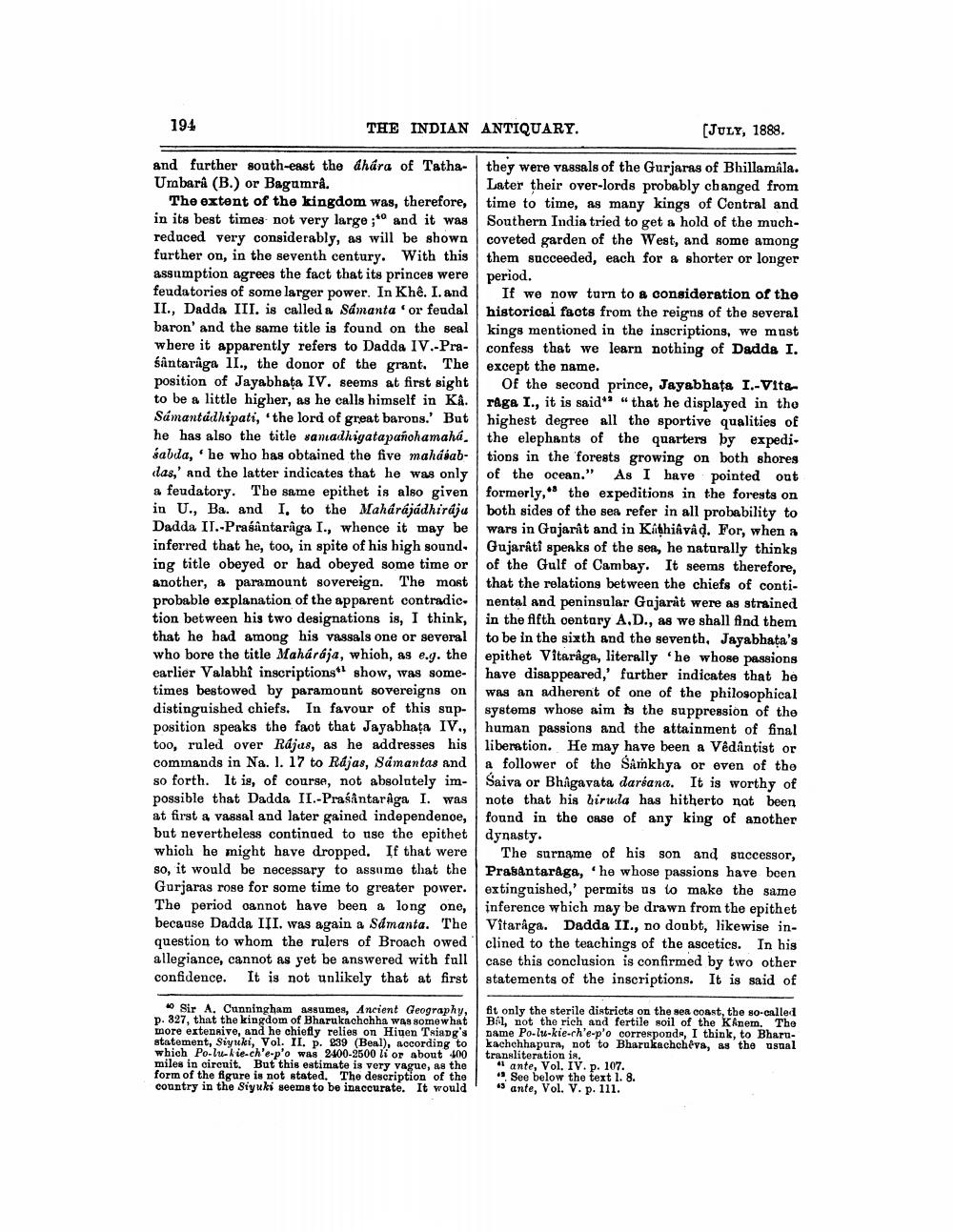________________
194
THE INDIAN ANTIQUARY.
[JULY, 1888.
and further south-east the dhára of Tatha- they were vassals of the Gurjaras of Bhillamila. Umbarâ (B.) or Bagumrå. Later their over-lords probably changed from time to time, as many kings of Central and Southern India tried to get a hold of the muchcoveted garden of the West, and some among them succeeded, each for a shorter or longer period.
If we now turn to a consideration of the historical facts from the reigns of the several kings mentioned in the inscriptions, we must confess that we learn nothing of Dadda I. except the name.
"
The extent of the kingdom was, therefore, in its best times not very large; and it was reduced very considerably, as will be shown further on, in the seventh century. With this assumption agrees the fact that its princes were feudatories of some larger power. In Khê. I. and II., Dadda III. is called a Samanta 'or feudal baron' and the same title is found on the seal where it apparently refers to Dadda IV.-Praśântaraga II., the donor of the grant. The position of Jayabhata IV. seems at first sight to be a little higher, as he calls himself in Kâ. Samantadhipati, 'the lord of great barons.' But he has also the title samadhigatapañohamahá. sabda, he who has obtained the five maháśabdas,' and the latter indicates that he was only a feudatory. The same epithet is also given in U., Ba. and I. to the Mahárájádhirája Dadda II.-Praśântarâga I., whence it may be inferred that he, too, in spite of his high sound. ing title obeyed or had obeyed some time or another, a paramount sovereign. The most probable explanation of the apparent contradic. tion between his two designations is, I think, that he had among his vassals one or several who bore the title Mahárája, which, as e.g. the earlier Valabhi inscriptions show, was sometimes bestowed by paramount sovereigns on distinguished chiefs. In favour of this supposition speaks the fact that Jayabhața IV., too, ruled over Rájus, as he addresses his commands in Na. 1. 17 to Rájas, Sámantas and so forth. It is, of course, not absolutely impossible that Dadda II.-Praśântaraga I. was at first a vassal and later gained independence, but nevertheless continued to use the epithet which he might have dropped. If that were so, it would be necessary to assume that the Gurjaras rose for some time to greater power. The period cannot have been a long one, because Dadda III. was again a Samanta. The question to whom the rulers of Broach owed allegiance, cannot as yet be answered with full confidence. It is not unlikely that at first
40 Sir A. Cunningham assumes, Ancient Geography, p. 327, that the kingdom of Bharukachchha was somewhat more extensive, and he chiefly relies on Hiuen Tsiang's statement, Siyuki, Vol. II. p. 239 (Beal), according to which Po-lu-kie-ch'e-p'o was 2400-2500 li or about 400 miles in circuit. But this estimate is very vague, as the form of the figure is not stated. The description of the country in the Siyuki seems to be inaccurate. It would
Of the second prince, Jayabhata I.-Vitaraga I., it is said "that he displayed in the highest degree all the sportive qualities of the elephants of the quarters by expeditions in the forests growing on both shores of the ocean." As I have pointed out formerly, the expeditions in the forests on both sides of the sea refer in all probability to wars in Gujarât and in Kathiâvad. For, when a Gujarati speaks of the sea, he naturally thinks of the Gulf of Cambay. It seems therefore, that the relations between the chiefs of continental and peninsular Gujarat were as strained in the fifth century A.D., as we shall find them to be in the sixth and the seventh, Jayabhata's epithet Vitaråga, literally 'he whose passions have disappeared,' further indicates that he was an adherent of one of the philosophical systems whose aim is the suppression of the human passions and the attainment of final liberation. He may have been a Vêdântist or a follower of the Samkhya or even of the Saiva or Bhagavata darsana. It is worthy of note that his biruda has hitherto not been found in the case of any king of another dynasty.
The surname of his son and successor, Prasantaraga, he whose passions have been extinguished,' permits us to make the same inference which may be drawn from the epithet Vitaråga. Dadda II., no doubt, likewise inclined to the teachings of the ascetics. In his case this conclusion is confirmed by two other statements of the inscriptions. It is said of
fit only the sterile districts on the sea coast, the so-called Bal, not the rich and fertile soil of the Kanem. The name Po-lu-kie-ch'e-p'o corresponds, I think, to Bharukachchhapura, not to Bharukachcheva, as the usual transliteration is.
41 ante, Vol. IV. p. 107.
See below the text 1. 8.
ante, Vol. V. p. 111.
43




